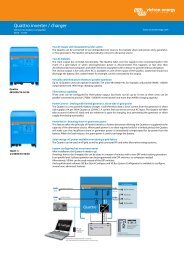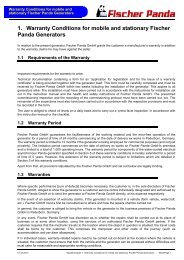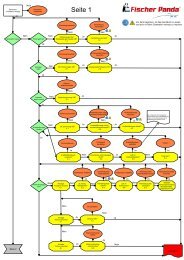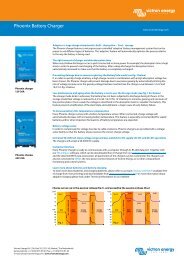Victron "Energy Unlimited" - Utu
Victron "Energy Unlimited" - Utu
Victron "Energy Unlimited" - Utu
You also want an ePaper? Increase the reach of your titles
YUMPU automatically turns print PDFs into web optimized ePapers that Google loves.
3.1.2. Battery voltage<br />
Battery voltage too can be used as a rough indication of the battery’s state of charge (see preceding table, section 3.1.1).<br />
Important: the battery should be left undisturbed for several hours (no charging or discharging) before a valid voltage<br />
measurement is possible.<br />
3.1.3. Amp-hour meter<br />
This is the most practical and accurate way to monitor a battery’s state of charge. The product designed for this is the<br />
battery monitor. The following sections look in more detail at the use of the battery monitor.<br />
3.2. The battery monitor is an amp-hour meter<br />
The battery monitor’s main function is to follow and indicate the DoD of a battery, in particular to prevent unexpected total<br />
discharge.<br />
A battery monitor keeps track of the current flowing in and out of the battery. Integration of this current over time (which if<br />
the current would be a fixed amount of amps, boils down to multiplying current and time) gives the amount of amp-hours<br />
flowing in or out of the battery.<br />
For example: a discharge current of 10 A for 2 hours means that the battery has been discharged by 10 x 2 = 20 Ah.<br />
3.3. <strong>Energy</strong> efficiency of a battery<br />
When a battery is charged or discharged losses occur. The total quantity of electric energy that the battery takes up<br />
during charging is approx. 25 % greater than the energy given out during discharging, which means an efficiency of 75<br />
%. High charge and discharge rates will further reduce efficiency. The greatest loss occurs because the voltage is higher<br />
during charging than during discharging, and this occurs in particular during absorption. Batteries that do not gas much<br />
(low antimony batteries) and that have a low internal resistance are the most efficient.<br />
When a battery is used in the partial state-of-charge mode (see the example in section 2.5.6.), its energy efficiency will<br />
be quite high: approx. 89 %.<br />
To calculate Ah charge or discharge of a battery, a battery monitor only makes use of current and time, so compensation<br />
for the overall efficiency is not needed.<br />
3.4. Charge efficiency of a battery<br />
When a battery is charged, more Ah has to be “pumped” in the battery than can be retrieved during the next discharge.<br />
This is called charge efficiency, or Ah or Coulomb efficiency (1 Ah = 3600 C).<br />
The charge efficiency of a battery is almost 100 %, as long as no gas generation takes place. Gassing means that part<br />
of the charging current is not transformed into chemical energy that is stored in the plates, but used to decompose water<br />
into oxygen and hydrogen gas (this is also true for the “oxygen only” end of charge phase of a sealed battery, see section<br />
2.3.2.). The “amp-hours” stored in the plates can be retrieved during the next discharge whereas the “amp-hours” used to<br />
decompose water are lost.<br />
The extent of the losses, and therefore the charge efficiency depends on:<br />
A. The type of battery: low gassing = high charge efficiency.<br />
B. The way in which the battery is charged. If a battery is mainly used in partial state of charge (see the example in<br />
section 2.5.6.) and only charged up to 100 % now and again, the average charge efficiency will be higher than if a<br />
battery is recharged to 100 % after each discharge.<br />
C. Charge current and voltage. When charging with a high current and therefore also a high voltage and a high<br />
temperature, gassing will start earlier and will be more intensive. This will reduce charge efficiency (and also the<br />
overall energy efficiency).<br />
In practice charge efficiency will range in between 80 % and 95 %. A battery monitor must take the charge efficiency into<br />
account, otherwise its reading will tend to be too optimistic. If the charge efficiency has to be pre-set manually it is<br />
advisable to initially choose a low value, for example 85 %, and adjust later to suit practice and experience.<br />
<strong>Victron</strong> <strong>Energy</strong> BV ©<br />
21

















